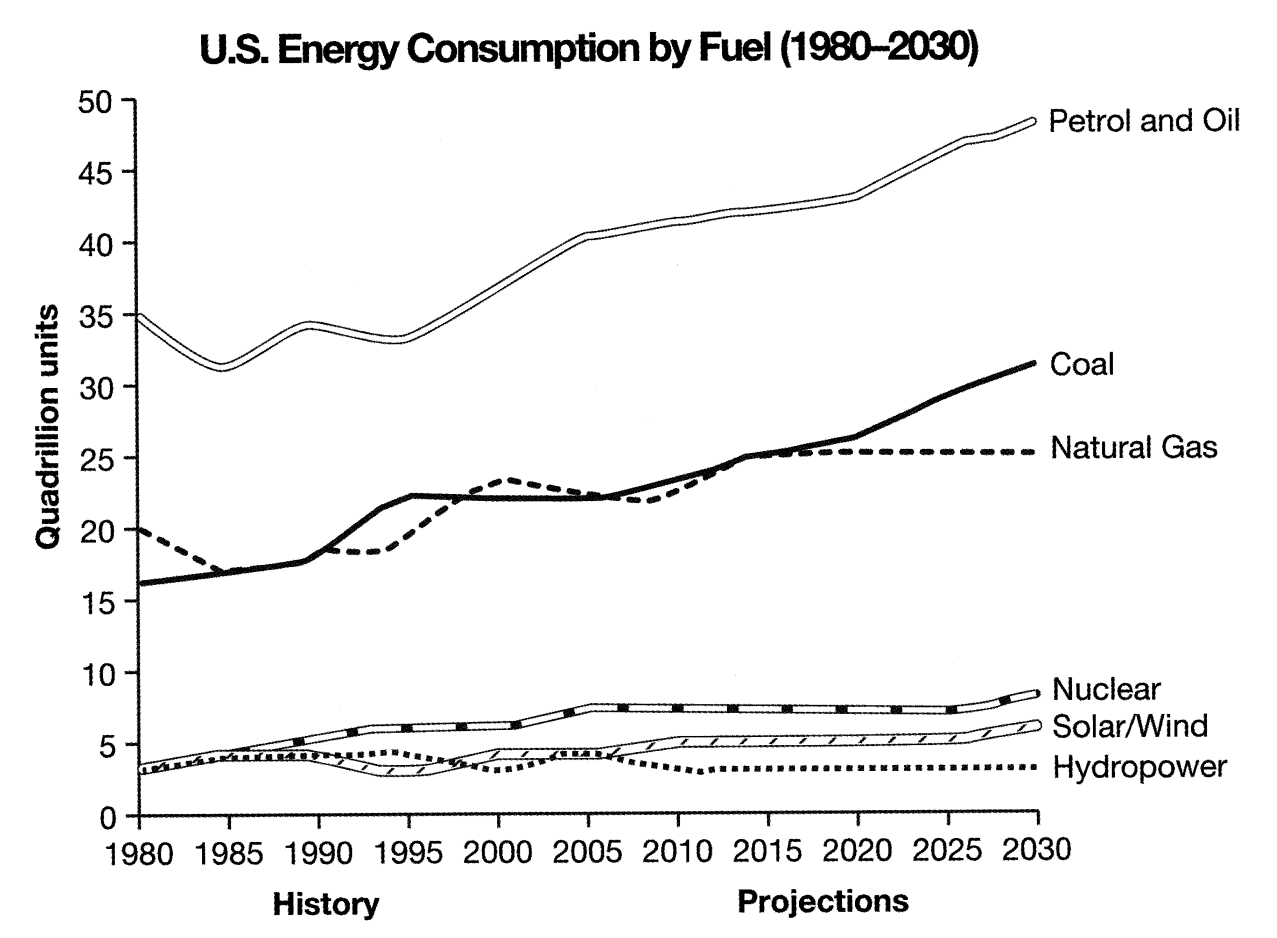Task 1
You should spend about 20 minutes on this task.
The graph below gives information from a 2008 report about consumption of energy in the USA since 1980 with projections until 2030.
Summarise the information by selecting and reporting the main features, and make comparisons where relevant.
Write at least 150 words.

Task 2
You should spend about 40 minutes on this task.
Write about the following topic:
Every year several languages die out. Some people think that this is not important because life will be easier if there are fewer languages in the world.
To what extent do you agree or disagree with this opinion?
Give reasons for your answer and include any relevant examples from your own knowledge or experience.
Write at least 250 words.
Cambridge IELTS 9 Academic Writing Test 4 Task 1 Model Answer (202 words)
The graph shows energy consumption in the US from 1980 to 2012, and projected consumption to 2030.
Petrol and oil are the dominant fuel sources throughout this period, with 35 quadrillion (35q) units used in 1980, rising to 42q in 2012. Despite some initial fluctuation, from 1995 there was a steady increase. This is expected to continue, reaching 47q in 2030.
Consumption of energy derived from natural gas and coal is similar over the period. From 20q and 15q respectively in 1980, gas showed an initial fall and coal a gradual increase, with the two fuels equal between 1985 and 1990. Consumption has fluctuated since 1990 but both now provide 24q. Coal is predicted to increase steadily to 31q in 2030, whereas after 2014, gas will remain stable at 25q.
In 1980, energy from nuclear, hydro- and solar/wind power was equal at only 4q. Nuclear has risen by 3q, and solar/wind by 2. After slight increases, hydropower has fallen back to the 1980 figure. It is expected to maintain this level until 2030, while the others should rise slightly after 2025.
Overall, the US will continue to rely on fossil fuels, with sustainable and nuclear energy sources remaining relatively insignificant.
Cambridge IELTS 9 Academic Writing Test 4 Task 2 Model Answer (309 words)
The extinction of languages is a complex phenomenon that raises questions about cultural diversity, identity, and the interconnectedness of the global community. While some argue that having fewer languages would simplify communication and make life easier, I strongly disagree with this viewpoint. Preserving linguistic diversity is essential for maintaining the richness of human culture, fostering understanding, and preserving unique ways of thinking.
Firstly, languages are carriers of cultural heritage and identity. Each language encapsulates the unique history, traditions, and worldview of a particular community. When a language dies, a wealth of cultural knowledge and expressions disappears with it. For example, indigenous languages often contain valuable insights into sustainable living, local ecosystems, and medicinal practices. Losing these languages means losing a part of humanity’s collective wisdom.
Secondly, linguistic diversity plays a crucial role in fostering mutual understanding and tolerance. A world with fewer languages may seem more convenient for communication, but it also risks homogenizing cultures. Language is not just a tool for communication; it shapes the way we perceive the world. Having a variety of languages allows for different perspectives and ways of thinking, promoting a more inclusive and tolerant global society.
Furthermore, maintaining linguistic diversity has practical benefits. Languages often evolve to adapt to specific environmental or societal needs. For example, some languages have unique vocabularies related to specific landscapes or climates. Losing these languages could mean losing valuable insights into adapting to environmental challenges.
In conclusion, the extinction of languages is a matter of great concern. Preserving linguistic diversity is crucial for maintaining cultural richness, promoting understanding, and addressing practical challenges. While it might be tempting to think that life would be easier with fewer languages, the long-term consequences for human society far outweigh any short-term convenience. Efforts should be made to document, revitalize, and celebrate linguistic diversity to ensure a more vibrant and inclusive global community.
Leave a Reply